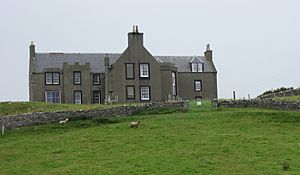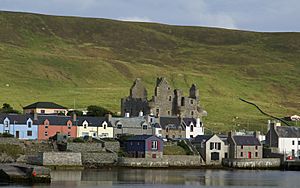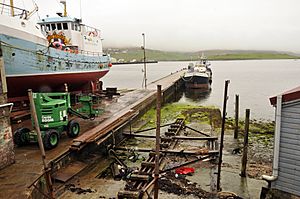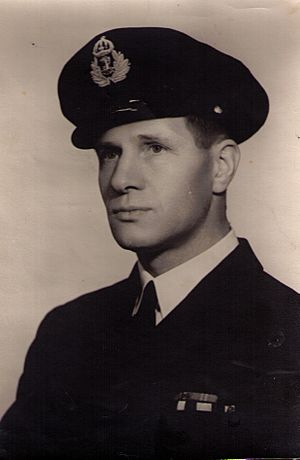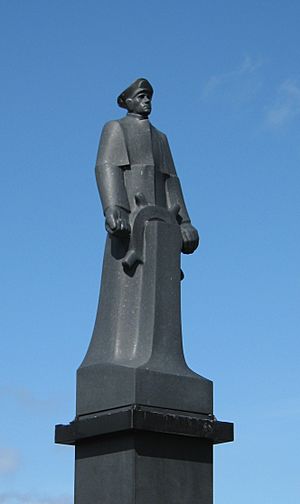Shetland bus facts for kids

The Shetland Bus was the secret nickname for a special group that created a hidden link between Shetland in Scotland and German-occupied Norway. This link lasted from 1941 until Germany surrendered on May 8, 1945. This brave group was first known as the Norwegian Naval Independent Unit (NNIU) from mid-1942. Later, in October 1943, it became an official part of the Royal Norwegian Navy and was called the Royal Norwegian Naval Special Unit (RNNSU).
At first, the group used many small fishing boats. Later, they added three fast and well-armed submarine chasers: Vigra, Hessa, and Hitra. Most trips happened in winter, hidden by darkness. This meant the crews and passengers faced very rough North Sea weather. They had to travel without lights and were always at risk of being found by German planes or patrol boats. There was also the danger of being caught while on missions along the Norwegian coast.
To stay safe, the boats were disguised as regular fishing boats, and the crews dressed like fishermen. They even hid light machine guns inside oil drums on deck. The German forces were a constant threat. Some missions went wrong, like the sad event in Telavåg in spring 1942. Several fishing boats were lost early on. But after the three submarine chasers joined, no more boats were lost.
Contents
History of the Shetland Bus
Norwegians Arrive in Shetland
When Germany attacked Norway on April 9, 1940, during Operation Weserübung, British and French troops tried to help. Many coastal towns were bombed. By April and May, British ships had to leave central Norway. On April 29, HMS Glasgow left the damaged city of Molde. On board were King Haakon VII, Crown Prince Olav, members of the Norwegian Government, and most of the gold from the Norwegian National Bank. Fighting continued in northern Norway for another month. A few weeks after the occupation began, many fishing boats and other vessels started arriving in Shetland. Some boats made several trips across the North Sea, bringing refugees to safety.
Many of these boats were "Hardanger Cutters" from the Bergen area, or "Møre Cutters" from around Ålesund. The "Møre Cutter" seemed stronger and better for the rough North Sea. The boats used for the "Shetland Bus" were usually about 50 to 70 feet (15 to 21 meters) long. They had two masts and a 30 to 70 horsepower single-cylinder engine that made a special "tonk-tonk" sound.
How the Group Started
In late 1940, two British secret groups, the Secret Intelligence Service (SIS) and the Special Operations Executive (SOE) Norwegian Naval Independent Unit, set up a base in Lerwick. SIS later moved to Peterhead. They asked some of the Norwegian boat skippers if they would go back to Norway. Their job would be to drop off secret agents and bring others back to Shetland. This continued through the winter of 1940–41. In early 1941, it was officially decided to create a group of men and boats to help SIS and SOE.
The main goal of this group was to move agents in and out of Norway. They also delivered weapons, radios, and other supplies. They would also rescue Norwegians who feared being arrested by the Germans. Sometimes, the group helped with special military operations. These included the failed attack on the German battleship Tirpitz, and raids like Operation Archery in Måløy and Operation Claymore in the Lofoten Islands.
Major Leslie Mitchell, a British Army officer, and his assistant, Lieutenant David Howarth from the Royal Naval Volunteer Reserve, were put in charge. They took over Flemington House (later called "Kergord") in Weisdale as their main office. They found a perfect spot in Lunna Ness, north of Lerwick, for the boats to operate from. Lunna Ness had a safe harbor and few people, so not many would notice what was happening. Lunna House was used to house the boat crews. Howarth set up his office there. Their small staff included three British sergeants, a stenographer, a Norwegian cook, and two maids. During the first winter, Flemington House was used to train secret agents and house Norwegian refugees. Later, refugees went to a special camp in Lerwick.
Bases and Facilities
At first, there were no easy ways to repair the boats in Lunna. So, boats had to be fixed in Lerwick. Later, the boats and crews moved to Scalloway. There, William Moore & Son had a workshop, and "Prince Olav's Slipway" was built. Harald Angeltveit and Johan Haldorsen were the main mechanics, and Severin Roald led the carpenters. All ship repairs happened in Scalloway, but Lunna Voe was still used for planning special missions.
Dinapore House became the main office for the base in Scalloway. Flemington House was used for agents waiting to go to Norway and for debriefings when they returned. A building that used to store fishing nets became a place for the boat crews to live and was called "Norway House." Sevrin Roald's wife, Inga Roald, was the housekeeper. Important officers, like the Commander-in-chief of the Scottish Command, sometimes visited Flemington House. The most important guest was Crown Prince Olav of Norway in October 1942. Mitchell left the Scalloway base in December 1942. Captain Arthur William Sclater, known as "Rogers," took over. His Norwegian-born wife, Alice, helped look after the crews.
Shetland Bus Operations
Initially, there were fourteen fishing boats of different sizes. The very first Shetland Bus trip was by the boat Aksel, led by August Nærøy. It left Hamna Voe on August 30, 1941, heading for Bergen. Other crew members on this first trip were Mindor Berge, Ivar Brekke, Andreas Gjertsen, and Bård Grotle. Fishing boats were used at first, but after some were lost, it was decided that faster ships were needed. On October 26, 1943, the US Navy officially gave three submarine chasers – Hitra, Vigra, and Hessa – to the Shetland Bus operation. These ships were 110 feet (34 meters) long and had two powerful 1,200 horsepower diesel engines. They could go up to 22 knots (41 km/h) and usually cruised at 17 knots (31 km/h). When these submarine chasers arrived, the group became an official part of the Royal Norwegian Navy. It was then renamed the Royal Norwegian Naval Special Unit (RNNSU).
- KNM Hitra was led by Ingvald Eidsheim.
- Vigra was led by Leif Larsen.
- Hessa was led by Petter Salen.
These three ships made over 100 trips to Norway without losing any men or ships.
On May 9, 1945, Vigra, led by Larsen, and Hitra, led by Eidsheim, entered the harbor of Lyngøy near Bergen in a free Norway. The Shetland Bus group had made 198 trips to Norway using fishing boats and submarine chasers. Leif Larsen completed 52 of these trips. The "Shetland Bus" had transported 192 agents and 383 tons of weapons and supplies to Norway. It also brought out 73 agents and 373 refugees. Sadly, forty-four members of the group were killed during the operations.
Brave Members of the Shetland Bus
The crews of the Shetland Bus (called Shetlandsgjengen in Norwegian) were mostly fishermen and sailors from the coast of Norway. They knew the local waters very well. Most of them came to Shetland after Norway was occupied. Some came with their own boats, others with boats that were "borrowed" with the owner's permission. They were young men, many in their twenties, some even younger. Many of them made several trips in the spring and summer of 1940. They helped evacuate British soldiers who were stuck in Norway and other British citizens living there.
Leif Larsen, the Famous "Shetlands Larsen"
Leif Larsen (born January 9, 1906 – died October 12, 1990) was nicknamed Shetlands Larsen. He was perhaps the most famous of the Shetland Bus men. He made 52 trips to Norway in total. He became the most decorated Allied naval officer of World War II. Larsen was born in Bergen, Norway. He joined Norwegian volunteers during the Finnish Winter War. Soon after that war ended, Germany invaded Norway. Larsen fought in eastern Norway until June 8, 1940.
Larsen arrived in Shetland on the boat M/B Motig I on February 11, 1941. After training in England and Scotland, Larsen returned to Lerwick on August 19, 1941. He made his first Shetland Bus trip on M/B Siglaos, led by Petter Salen, on September 14, 1941. After his ship, the minelayer Nordsjøen, was lost, Larsen became a skipper and could choose his own crew. His first crew included Palmer Bjørnøy, Leif Kinn, Arne Kinn, Kåre Iversen, Karsten Sangolt, Nils Nipen, and Otto Pletten. His first boat as skipper was M/K Arthur. This was the boat he had taken when escaping from Norway after Nordsjøen was wrecked. On November 8, 1941, Larsen sailed from Shetland on his first trip as skipper. On their way back, they hit a storm, and Sangolt was swept overboard and drowned. Larsen made several trips with the Arthur, but he also skippered other boats like M/B Siglaos and M/B Feie. In October 1942, he had to sink the Arthur in Trondheimsfjord after a failed attempt to attack the German warship Tirpitz. He and his crew escaped to Sweden, but a British agent, A.B. Evans, was arrested and later shot.
On March 23, 1943, while returning from Træna, Nordland, on M/K Bergholm, they were attacked by German aircraft. The boat was sunk. Larsen and his crew, many of them hurt, rowed for several days until they reached the coast of Norway near Ålesund. Sadly, Nils Vika died from his wounds. The other crew members were Andreas Færøy, Johannes Kalvø, Finn Clausen, Gunnar Clausen, Odd Hansen, and William Enoksen. After hiding in different places, they were rescued on April 14 by a Motor Torpedo Boat (MTB 626) from Lerwick. In October 1943, the new submarine chasers arrived, and Larsen became the commander of Vigra, with the rank of Sub-Lieutenant. In total, he made 52 trips to Norway in both fishing vessels and submarine chasers.
Larsen received many awards for his bravery:
- British awards: Conspicuous Gallantry Medal, Distinguished Service Medal and Bar, Distinguished Service Cross, Distinguished Service Order.
- Norwegian awards: War Cross with sword (Krigskors med sverd og stjerne), St Olav's medal (St. Olavsmedaljen med eikegren), Norwegian War Medal (Krigsmedaljen), Defence Medal 1940–1945 (Deltagermedaljen med rosett).
Kåre Iversen, the Engineer
Kåre Emil Iversen (born October 10, 1918 – died August 22, 2001) was born in Flatanger, Norway. His father was a sea pilot, and Kåre often joined him on the pilot boat. When the Germans attacked Norway, Kåre was a fisherman and quickly joined the underground army. The Germans found out about his activities, so he had to leave Norway. He and three other men escaped to Shetland in August 1941 using his father's boat, the 42-foot Villa II. From Shetland, he went to England, where he trained with the Kompani Linge. He was one of the men Larsen chose as crew on M/B Arthur and made several trips with Larsen. He also served as a crewman on M/B Siglaos, M/B Feie, M/B Harald, and M/B Heland. In December 1943, he became the engineer on the submarine chaser Hessa, under Petter Salen. When Hessa was being repaired, Iversen worked as an engineer on Vigra and made one trip on a Norwegian Navy MTB. When Hessa was ready again, he rejoined its crew and stayed there until the war ended. Kåre Iversen made 57 trips across the North Sea, most of them as an engineer. On December 6, 1944, he married Christine 'Cissie' Slater from Scalloway. They stayed in Scalloway after the war and had three daughters. In 1996, Iversen's memories were published in a book called I Was a Shetland Bus Man, which was reprinted in 2004 with the new title Shetland Bus Man.
Memorials to the Shetland Bus
The first Shetland Bus man to die was Nils Nesse, 23, from Bremnes, Norway. He was killed on October 28, 1941, when German aircraft attacked the Siglaos on its way to Shetland from Norway. Nesse was buried at Lunna Kirk churchyard with a Scottish ceremony, as there was no Norwegian priest available. His body was moved back to Norway in 1948, but a cross still marks his grave at Lunna. Nesse was the second Norwegian buried at Lunna Kirk. The first was an unknown sailor buried on February 5, 1940. He was likely from the cargo ship Hop, which was sunk by a German submarine. The third man was buried on June 9, 1942. He was found floating in the sea by a local farmer. The "Shetland–Norwegian Friendship Society" has placed a plaque on the churchyard wall to remember these two unknown men. British naval officer and author David Armine Howarth (1912 – 1991) asked for his ashes to be scattered over the water at Lunna Voe. A memorial plaque for him is also on the churchyard wall at Lunna Kirk.
The Shetland Bus Memorial is located in Scalloway. The local museum there has a special exhibit about the Shetland Bus. In 2018, Norwegian visitors were among those who attended a service at the memorial. They gathered to celebrate the 75th anniversary of when the new, safer ships – the Hitra, Vigra, and Hessa – joined the operations.
|
See also
Note
This article incorporates text from the article Shetland Bus The Shetland Bus on Shetlopedia, which was licensed under the GNU Free Documentation Licence until September 14, 2007.


